4.4 Altered States of Consciousness
We have now explored many levels of consciousness, from wide-
CONNECTIONS
In Chapter 2, we described neuro-
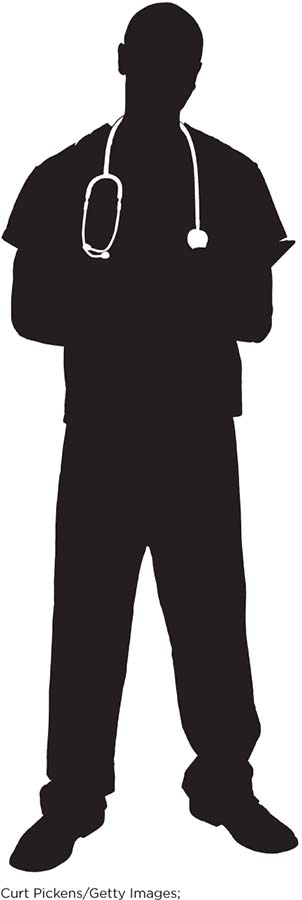 EMERGENCY IN THE NIGHT You wake in the middle of the night with a dull pain around your belly button. By morning, the pain is sharp and stabbing and has migrated to your lower right abdomen, so you head to the local emergency room where doctors diagnose you with appendicitis, an inflammation of the appendix often caused by infection. You need an emergency operation to remove your appendix, and a strong anesthetic is in order: a combination of drugs to paralyze the abdominal muscles, dull the pain, and wipe out your memory of the procedure. Dr. Julien, introduced at the start of the chapter, is your anesthesiologist.
EMERGENCY IN THE NIGHT You wake in the middle of the night with a dull pain around your belly button. By morning, the pain is sharp and stabbing and has migrated to your lower right abdomen, so you head to the local emergency room where doctors diagnose you with appendicitis, an inflammation of the appendix often caused by infection. You need an emergency operation to remove your appendix, and a strong anesthetic is in order: a combination of drugs to paralyze the abdominal muscles, dull the pain, and wipe out your memory of the procedure. Dr. Julien, introduced at the start of the chapter, is your anesthesiologist.
For paralysis, Dr. Julien would probably give you a drug similar to curare, an arrowhead poison used by South American natives. Curare works by blocking the activity of the neurotransmitter acetylcholine, which stimulates muscle contractions in the body. But curare does not cross into the brain, and therefore it does not have the power to transport you to another level of consciousness (Czarnowski, Bailey, & Bal, 2007). If curare were the only drug Dr. Julien administered, you would be lying on the operating table paralyzed yet completely awake and aware of your pain—
Psychoactive Drugs
LO 8 Define psychoactive drugs.
154
psychoactive drugs Substances that can cause changes in psychological activities such as sensation, perception, attention, judgment, memory, self-

Young smokers are more inclined than their nonsmoking peers to use illegal drugs, display aggression, and develop mental health problems. They also have a harder time quitting than those who start smoking in adulthood (American Cancer Society, 2012).
To dull the perception of pain, Dr. Julien might administer fentanyl, which belongs to a class of drugs called opioids that we will soon discuss. And to stamp out your memory of the surgery, he would lull you into a sleeplike stupor with a drug such as propofol and then maintain that state of sleep with other drugs. One moment you are awake, sensing, perceiving, thinking, and talking. The next moment you see nothing, hear nothing, feel nothing. It’s like you are gone. Fentanyl and propofol are considered psychoactive drugs because the chemicals they contain cause changes in psychological activities such as sensation, perception, attention, judgment, memory, self-
You don’t need to visit a hospital to have a psychoactive drug experience. Mind-
Psychoactive drugs alter consciousness in an untold number of ways. They can rev you up, slow you down, let down your inhibitions, and convince you that the universe is on the verge of collapse. We will discuss the three major categories of psychoactive drugs—
Depressants
LO 9 Identify several depressants and stimulants and know their effects.
Synonyms
depressants downers
barbiturate yellow jackets, pink ladies, goof balls, reds, rainbows
In his 25 years as an anesthesiologist, Dr. Julien has primarily relied on a group of psychoactive drugs that depress activity in the central nervous system, or slow things down. For this reason, they are called depressants. Dr. Julien sometimes premedicates patients, administering drugs to calm them while they wait to be wheeled into the operating room. He might use a benzodiazepine, which would act as a tranquilizer—
depressants A class of psychoactive drugs that depress or slow down activity in the central nervous system.
barbiturate (bär-
BARBITURATES Once a patient is in the operating room and ready for surgery, Dr. Julien puts him to sleep. This process is called “induction,” and it is sometimes accomplished using another type of depressant termed a barbiturate (bär-
155
INFOGRAPHIC 4.3
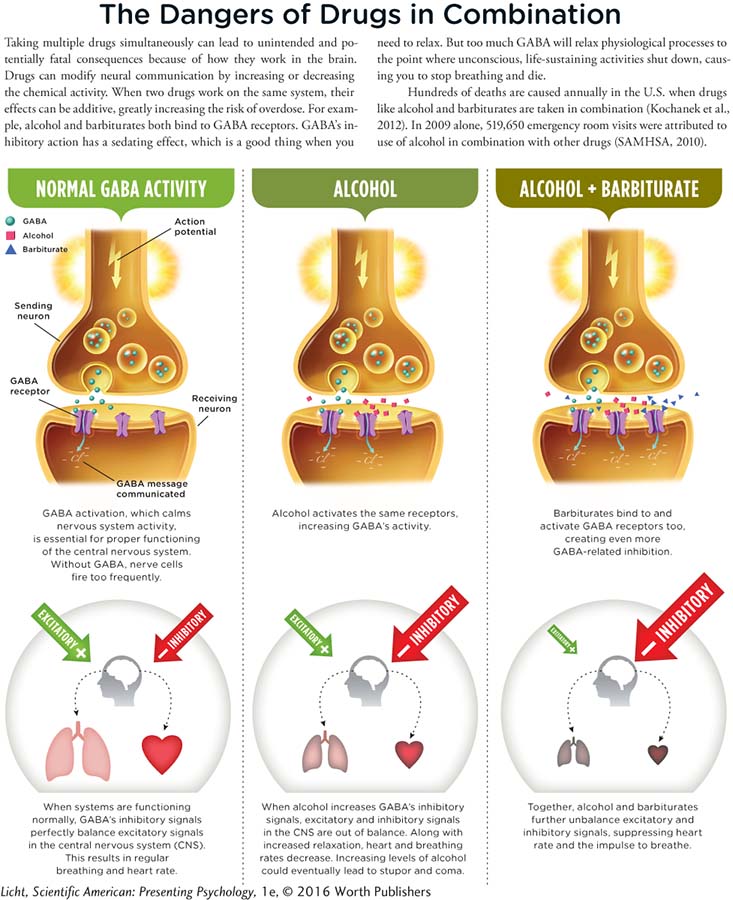
opiates A class of psychoactive drugs that cause a sense of euphoria; a drug that imitates the endorphins naturally produced in the brain.
opioids A class of psychoactive drugs that minimizes perceptions of pain.

Naturally occurring opioids, or opiates, are found in the opium poppy, the same plant that produces those little black seeds on your breakfast bagel. Doctors have been using the poppy opiate morphine to alleviate pain since the early 1800s (Julien et al., 2011).

Heroin is one of the most pleasure-
156
OPIOIDS Putting a patient to sleep is not enough to prepare him for a major surgery; he also needs drugs that combat pain. Even when a patient is out cold on the operating table, his brain receives pain impulses that without proper painkilling drugs can give rise to what Dr. Julien calls “autonomic instability,” a disruption of heart rate, blood pressure, and other activities regulated by the autonomic nervous system. One way to maintain autonomic stability is to give the patient an opioid, a drug that minimizes the brain’s perception of pain. “Opioid” is an umbrella term for a large group of similarly acting drugs, some found in nature and others concocted in laboratories (synthesized replacements such as methadone). Opioids block pain, induce drowsiness and euphoria, and slow down breathing (Julien et al., 2011). There are two types of naturally occurring opioids: the endorphins produced by your body, and the opiates found in the opium poppy. Morphine, which is derived from the opium poppy, is used to alleviate pain in medical settings; it also serves as the raw material for making the street drug heroin, which enters the brain more quickly and has 3 times the strength (Julien et al., 2011).
PRESCRIPTION DRUG ABUSE Few people in the United States actually use heroin (less than 1%; SAMHSA, 2014), and some studies suggest that number is decreasing. But another class of opioids appears to be taking its place—
Alcohol
We end our coverage of depressants with alcohol, which, like other drugs in its class, has played a central role in the history of anesthesia. The ancient Greek doctor Dioscorides gave his surgical patients a special concoction of wine and mandrake plant (Keys, 1945), and 19th-
BINGE DRINKING Alcohol is the most commonly used depressant in the United States. Around 15% of adults and 25% of teenagers report that they binge drink (consuming four or more drinks for women and five or more for men, on one occasion or within a short time span) at least once a month (Naimi et al., 2003; Wen et al., 2012). Many people think binge drinking is fun, but they might change their minds if they reviewed the research. Studies have linked binge drinking to poor grades, aggressive behavior, sexual promiscuity, and accidental death. In 2005 almost 2,000 college students in the United States died in alcohol-

Binge drinking has been associated with reduced mental and physical health. This effect appears to intensify with increasing levels of alcohol ingestion (Wen et al., 2012).
157
You don’t have to binge drink in order to have an alcohol problem (Figure 4.1). Some people cannot get through the day without a midday drink; others need alcohol to unwind or fall asleep. The point is there are many forms of alcohol misuse. About 8.5% of the adult population in the United States (nearly 1 in 10 people) struggle with alcohol dependence or some other type of drinking problem (Grant et al., 2004). Drinking can destroy families, careers, and human lives.
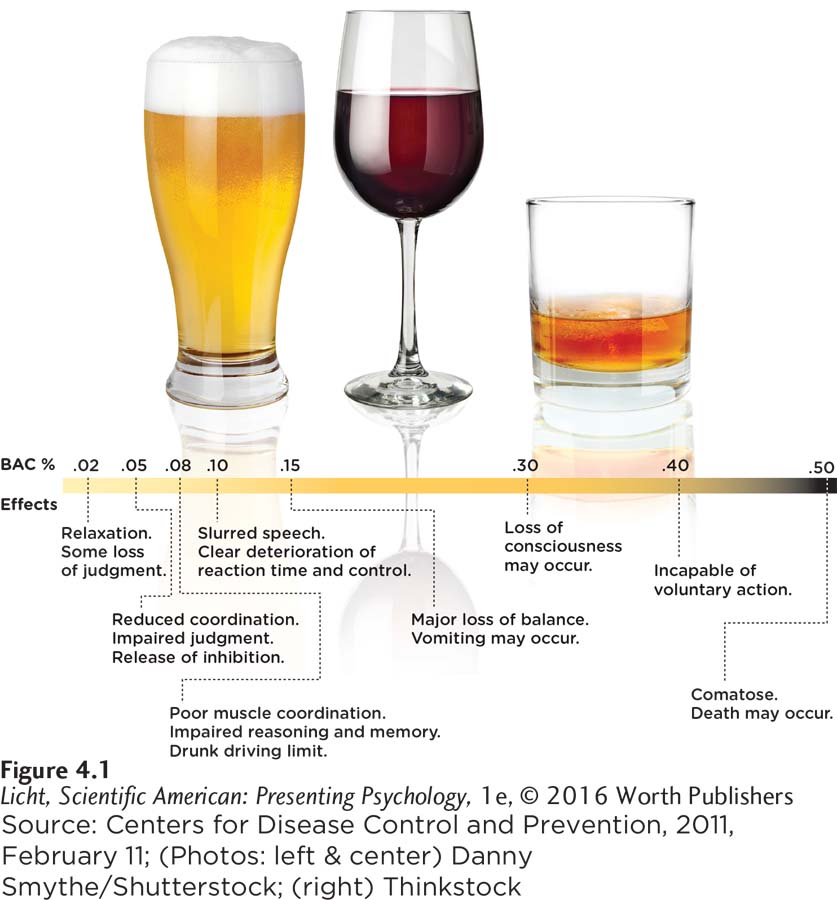
The effects of one drink—
ALCOHOL AND THE BODY Let’s stop for a minute and examine how alcohol influences consciousness (Figure 4.1). People sometimes say they feel “high” when they drink. How can such a statement be true when alcohol is a depressant, a drug that slows down activity in the central nervous system? Alcohol boosts the activity of GABA, a neurotransmitter that dampens activity in certain neural networks, including those that regulate social inhibition—
The female body is less efficient at breaking down (metabolizing) alcohol. Even when we control for body size and muscle-
158
THE CONSEQUENCES OF DRINKING Light alcohol consumption by adults—
Apply This
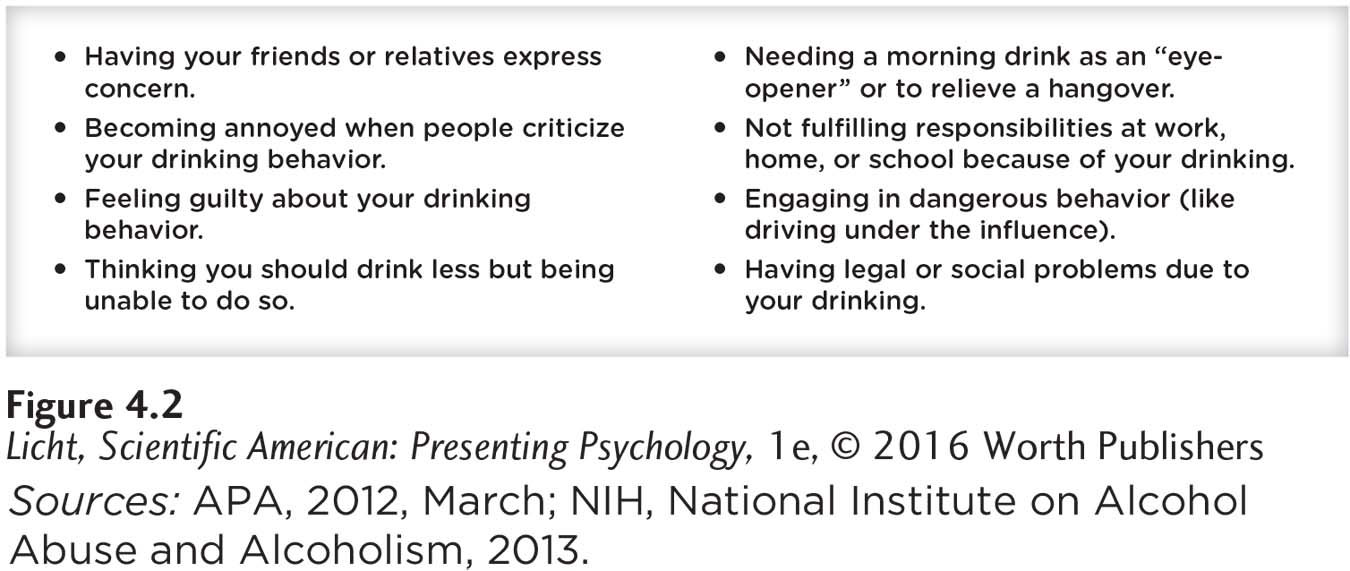
The presence of one or more of these warning signs could indicate a developing problem with alcohol.
Stimulants
stimulants A class of drugs that increase neural activity in the central nervous system.
Not all drugs used in anesthesia are depressants. Did you know that some doctors use cocaine as a local anesthetic for nose and throat surgeries (MedicineNet, 2014)? Cocaine is a stimulant—a drug that increases neural activity in the central nervous system, producing heightened alertness, energy, elevated mood, and other effects (Julien et al., 2011). When applied topically, cocaine blocks sensation in the peripheral nerves and thereby numbs the area.
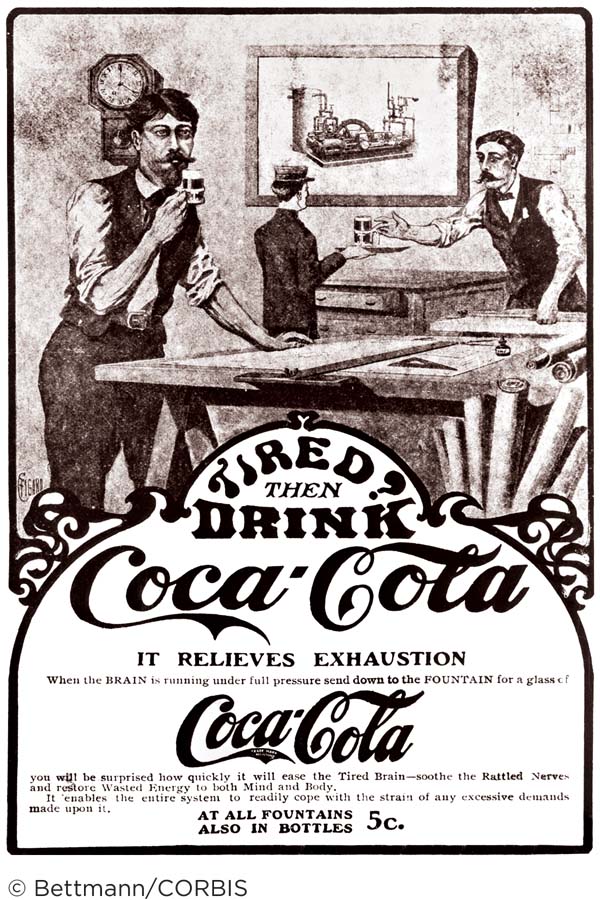
The original recipe for Coca-
COCAINE The first to tap into cocaine’s pain-
While cocaine is illegal in the United States and most other countries, it is among the most widely used illicit drugs. Depending on the form in which it is prepared (powder, rocks, and so on), it can be snorted, injected, or smoked. The sense of energy, euphoria, and other alterations of consciousness that cocaine induces after entering the bloodstream and infiltrating the brain last anywhere from 5 to 30 minutes (National Institute on Drug Abuse, 2013a). Cocaine produces a rush of pleasure and excitement by amplifying the effects of dopamine and norepinephrine. But the coke high comes at a steep price. Any time you take cocaine, you put yourself at risk for suffering a stroke or heart attack, even if you are young and healthy. Cocaine is implicated in more emergency room visits than any other illegal drug (Drug Abuse Warning Network, 2011). It is also extremely addictive. Many users find they can never quite duplicate the high they experienced the first time, so they take increasingly higher doses, developing a physical need for the drug, increasing their risk of effects such as anxiety, insomnia, and schizophrenia-
Synonyms
methamphetamine meth, crystal meth, crank
amphetamines speed, uppers, bennies
159
Cocaine use grew rampant in the 1980s. That was the decade crack—
amphetamines (am-

This woman appears to have aged 15 or 20 years, but the time elapsed between these two photos is just 2 1/2 years. Methamphetamine ravages the body, the brain, and one’s overall appearance. Some meth users have lingering symptoms: Imagine experiencing horrific tactile hallucinations that cause you to believe bugs have invaded your skin and are crawling underneath it, and that in response you tear your skin to the bone in order to kill them.
AMPHETAMINES Methamphetamine belongs to a family of stimulants called the amphetamines (am-
Ridiculously cheap, easy to make, and capable of producing a euphoric high lasting many hours, methamphetamine stimulates the release of the brain’s pleasure-
CAFFEINE Most people have not experimented with illegal stimulants like cocaine and meth, but many are regular users of caffeine. We usually associate caffeine with beverages like coffee, but this pick-
CONNECTIONS
In Chapter 1, we discussed the problem with possible third factors and correlations. Here, we need to be cautious about making too strong a statement about coffee causing positive health outcomes, because third factors could be involved in increased caffeine consumption and better health.
160
Moderate caffeine use (up to four cups of coffee per day) has been associated with increased alertness, enhanced recall ability, elevated mood, and greater endurance during physical exercise (Ruxton, 2008). Some studies have also linked moderate long-
TOBACCO What do you think is the number one cause of premature death worldwide—
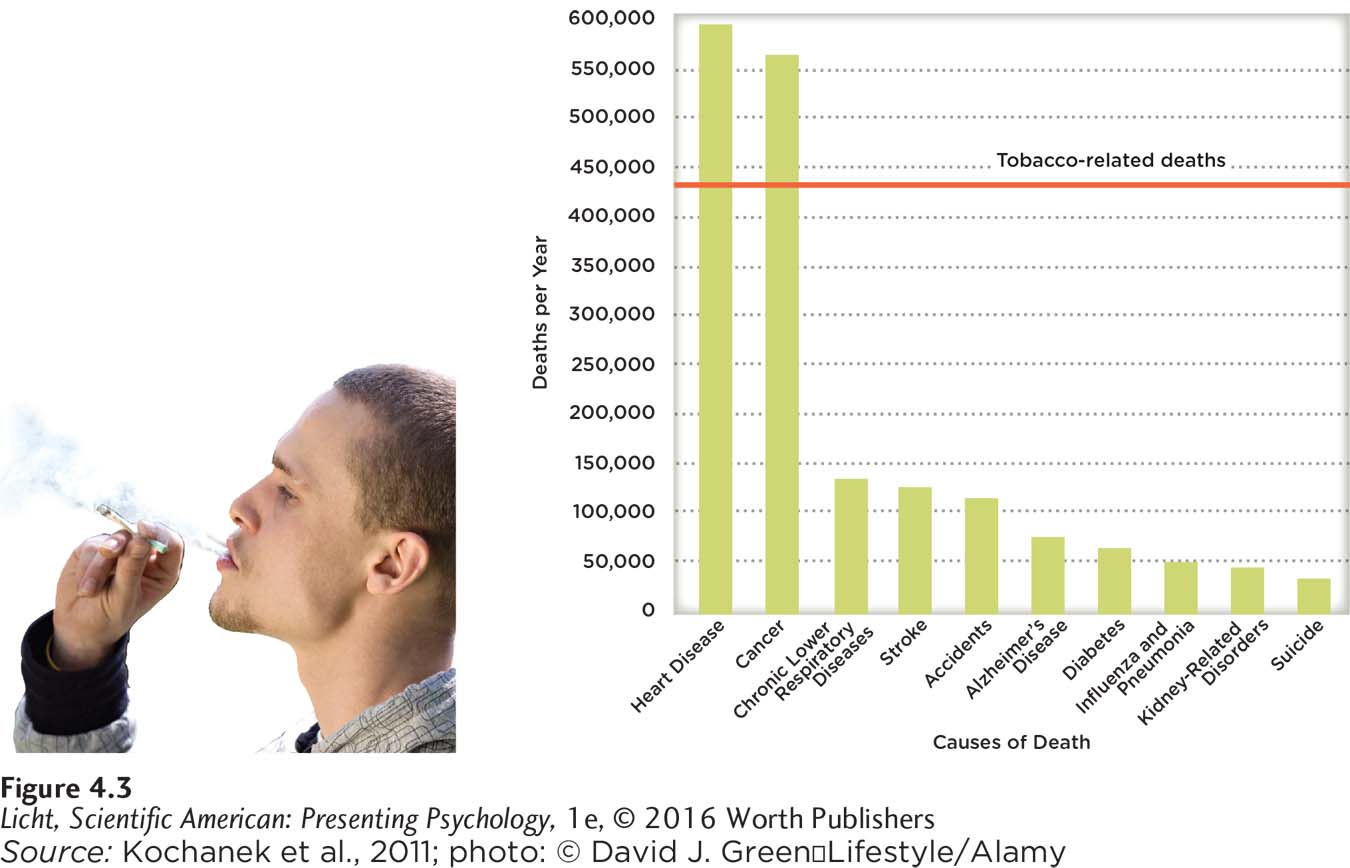
The leading killers in this country—
Despite these harrowing statistics, about 1 in 5 adults in the United States continues to light up (CDC, 2010). They say it makes them feel relaxed yet more alert, less hungry, and more tolerant of pain. And those who try to kick the habit find it exceedingly difficult. Cigarettes and other tobacco products contain a highly addictive stimulant called nicotine, which sparks the release of epinephrine and norepinephrine. Nicotine use appears to be associated with activity in the same brain area activated by cocaine, another drug that is extremely difficult to give up (Pich et al., 1997; Zhang, Dong, Doyon, & Dani, 2012). The few who succeed face a steep uphill battle. Around 90% of quitters relapse within 6 months (Nonnemaker et al., 2011), suggesting that relapse is a normal experience when quitting, not a sign of failure.
Synonyms
secondhand smoke passive smoke
hallucinogens psychedelic drugs
161
Smoking is not just a problem for the smoker. It is a problem for spouses, children, friends, and anyone who is exposed to the secondhand smoke. Secondhand smoke is particularly dangerous for children, whose developing tissues are highly vulnerable (Chapter 8). By smoking, parents increase their children’s risk for sudden infant death syndrome (SIDS), respiratory infections, asthma, and bronchitis (CDC, 2014). Secondhand smoke contributes to 21,400 lung cancer deaths and 379,000 heart disease deaths worldwide (Öberg, Jaakkola, Woodward, Peruga, & Prüss-
Hallucinogens
LO 10 Discuss some of the hallucinogens.
hallucinogens (hə-ˈlü-sə-nə-jənz) A group of psychoactive drugs that can produce hallucinations (auditory, visual, or kinesthetic), distorted sensory experiences, alterations of mood, and distorted thinking.
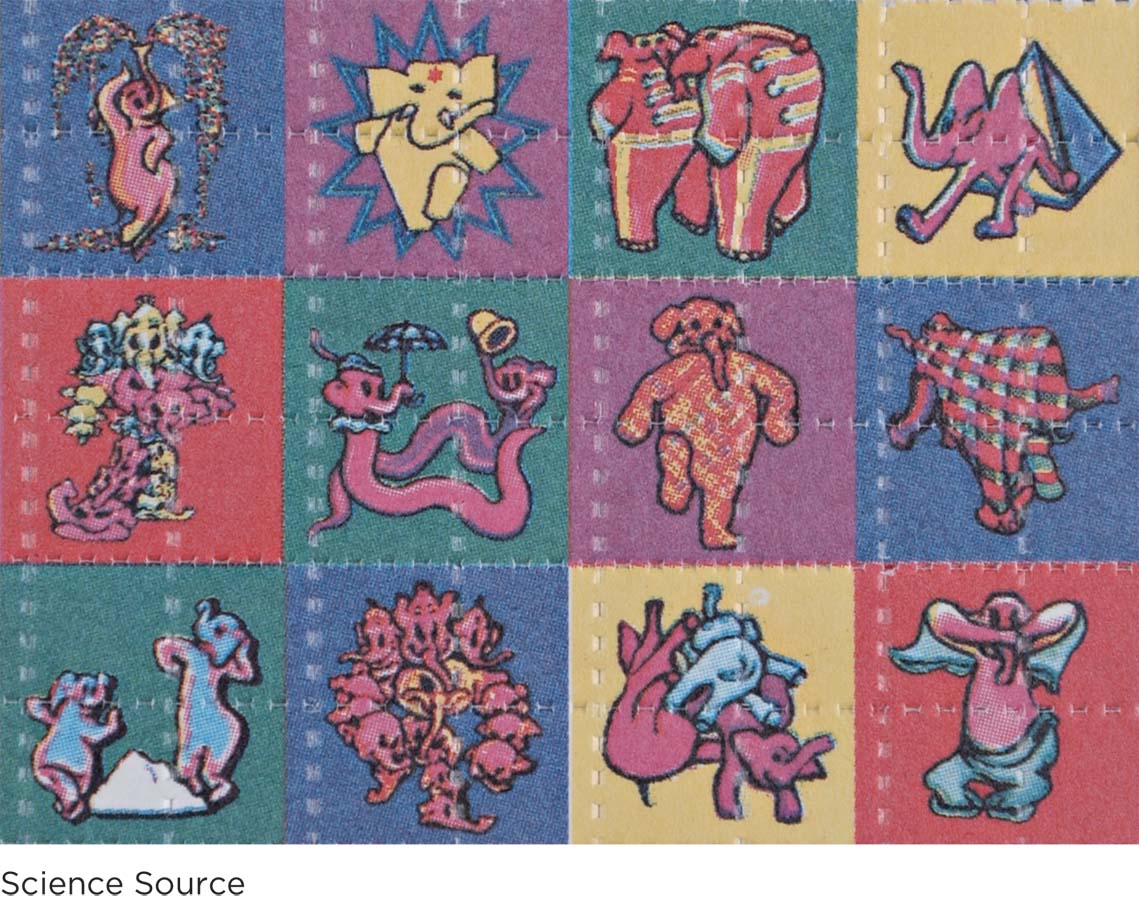
Lysergic acid diethylamide, or LSD, is usually taken by mouth, administered through candy, sugar cubes, or blotter sheets like the one pictured here. A popular drug during the “hippie” era of the 1960s and 1970s, LSD has now fallen out of favor.
We have learned how various depressants and stimulants are used in anesthesia. Believe it or not, there is also a place for hallucinogens (hə-ˈlü-sə-nə-jənz)—drugs that produce hallucinations (sights, sounds, odors, or other sensations of things that are not actually present), altered moods, and distorted perception and thought. Phencyclidine (PCP or angel dust) and ketamine (Special K ) are sometimes referred to as psychedelic anesthetics because they were developed to block pain and memory in surgical patients during the 1950s and 1960s (Julien et al., 2011). PCP is highly addictive and extremely dangerous. Because users cannot feel normal pain signals, they run the risk of unintentionally harming or killing themselves. Long-
lysergic acid diethylamide (LSD) (lə-ˈsər-
LSD The most well-
162
methylenedioxymethamphetamine (MDMA) (methˈı̆-lēn-
MDMA In addition to the traditional hallucinogens, there are quite a few “club drugs,” or synthetic “designer drugs,” used at parties, raves, and dance venues. The most popular among them is methylenedioxymethamphetamine (MDMA; methˈı̆-lēn-
An Ecstasy trip might bring on feelings of euphoria, love, openness, heightened energy, and floating sensations, as well as intense anxiety and depersonalization, with the user feeling like a detached spectator, watching himself from the outside without having any control. Ecstasy can also cause a host of changes to the body, including decreased appetite, lockjaw, blurred vision, dizziness, rapid heart rate, and dehydration (Gordon, 2001, July 5; Noller, 2009). Dancing in hot, crowded conditions while on Ecstasy can lead to severe heat stroke, seizures, even cardiac arrest and death (Parrott, 2004). Every year, thousands of Ecstasy users leave raves and all-
CONNECTIONS
In Chapter 2, we reported that serotonin is critical for the regulation of mood, appetite, aggression, and automatic behaviors like sleep. Here, we see how the use of Ecstasy can alter levels of this neurotransmitter.
Ecstasy triggers a sudden general unloading of serotonin in the brain, after which serotonin activity is temporarily depleted until its levels are restored (Klugman & Gruzelier, 2003). Studies of animals have shown that even short-
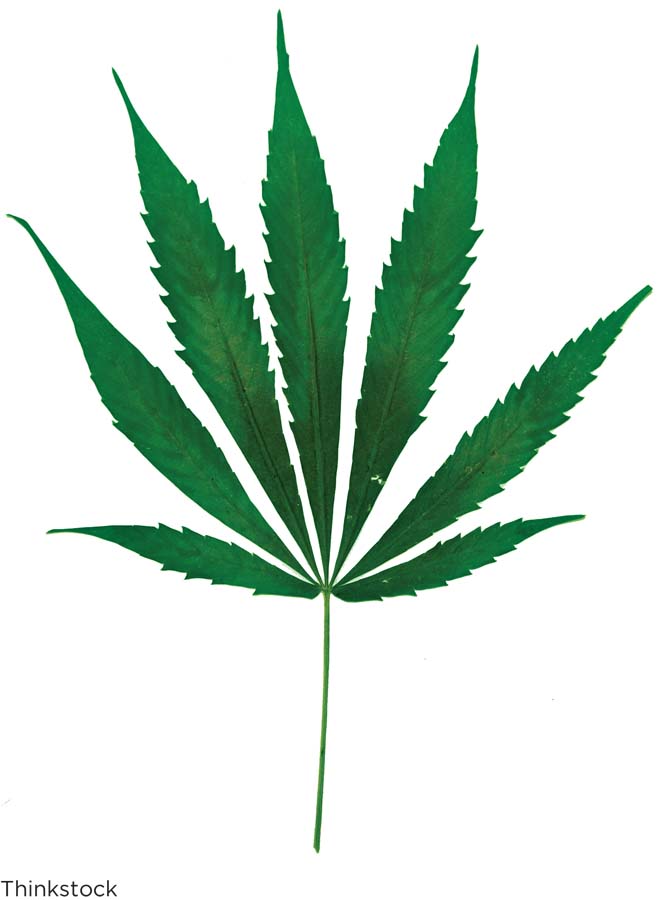
Marijuana is the most commonly used illicit drug in the world, consumed by 2.6% to 5% of the adult population. It is also the primary reason people seek drug treatment in many regions of the world, including North America (United Nations, 2012).
Synonyms
marijuana Mary Jane, M.J., grass, reefer, weed, pot, ganja, hemp
methylenedioxymethamphetamine E, X
MARIJUANA The most widely used illegal (in most states) drug, and one of the most popular in all the Western world, is marijuana (Compton, Grant, Colliver, Glantz, & Stinson, 2004; Degenhardt & Hall, 2012; SAMHSA, 2014). Forty-
163
Marijuana comes from the hemp plant, Cannabis sativa, which has long been used as—
tetrahydrocannabinol (THC) (te-
Marijuana’s active ingredient is tetrahydrocannabinol (THC; te-
Some of marijuana’s effects linger long after the initial high is over. Impairments in learning and memory may persist for days in adults (weeks for adolescents), and long-
Overuse and Addiction
We often joke about being “addicted” to our coffee or soda, but do we understand what this really means? In spite of frequent references to addiction in everyday conversations, the term has been omitted from the American Psychiatric Association’s diagnostic manual due to its “uncertain definition and potentially negative connotation” (American Psychiatric Association, 2013, p. 485). Historically, the term addiction has been used (both by laypeople and professionals) to refer to the urges people experience for using a drug or engaging in an activity to such an extent that it interferes with their functioning or is dangerous. This could mean a gambling habit that depletes your bank account, a sexual appetite that destroys your marriage, or perhaps even a social media fixation that prevents you from holding down a job.
SOCIAL MEDIA and psychology
Can’t Get Enough
 Is it difficult for you to sit through a movie without checking your Twitter “Mentions”? Are you constantly looking at your Facebook News Feed in between work e-
Is it difficult for you to sit through a movie without checking your Twitter “Mentions”? Are you constantly looking at your Facebook News Feed in between work e-
“. . .THE URGE TO USE MEDIA WAS HARDER TO RESIST THAN SEX, SPENDING MONEY, ALCOHOL. . . .”
Facebook and Twitter may be habit forming, but you would think these sites would be easier to resist than, say, coffee or cigarettes. Such is not the case, according to one recent study. With the help of smartphones, researchers kept tabs on the daily desires of 205 young adults and found the urge to use media was harder to resist than sex, spending money, alcohol, coffee, or cigarettes (Hofmann, Vohs, & Baumeister, 2012). These findings are thought provoking, and this line of research is one to follow, but don’t allow one study to minimize the serious and long-
164
LO 11 Explain how physiological and psychological dependence differ.
physiological dependence With constant use of some psychoactive drugs, the body no longer functions normally without the drug.
delirium tremens (DTs) Withdrawal symptoms that can occur when a heavy drinker suddenly stops or significantly cuts down alcohol consumption; can include sweating, restlessness, hallucinations, severe tremors, and seizures.
withdrawal With constant use of some psychoactive drugs, a condition in which the body becomes dependent and then reacts when the drug is withheld; a sign of physiological dependence.
PHYSIOLOGICAL AND PSYCHOLOGICAL DEPENDENCE Substance use can be fueled by both physiological and psychological dependence. Physiological dependence means the body no longer functions normally without the drug (see Figure 4.4 on drug dependence in the United States). Want to know if you are physiologically dependent on your morning cup of Joe? Try removing it from your routine for a few days and see if you get a headache or feel fatigued. If your answers are yes and yes, odds are that you have experienced withdrawal, a sign of physiological dependence. Withdrawal is the constellation of symptoms that surface when a drug is removed or withheld from the body, and it’s not always as mild as a headache and fatigue. An alcoholic who suddenly stops drinking (or significantly cuts down) may suffer from delirium tremens (DTs), withdrawal symptoms that include sweating, restlessness, hallucinations, severe tremors, and seizures. Withdrawal symptoms disappear when you take the drug again, and this of course makes you more likely to continue using it. (The removal of the unpleasant symptoms acts as negative reinforcement for taking the drug, a process you can learn about in Chapter 5.) In this way, withdrawal powers the addiction cycle.

This graph depicts the rates of drug dependence/abuse in the United States. As you can see, alcohol tops the list, followed by marijuana, and then pain relievers such as Vicodin and Oxycontin. The sedatives category includes barbiturates, which are powerful nervous system depressants.
tolerance With constant use of some psychoactive drugs, a condition in which the body requires more and more of the drug to create the original effect; a sign of physiological dependence.
Another sign of physiological dependence is tolerance. Persistent use of alcohol and other drugs alters the chemistry of the brain and body. Over time, your system adapts to the drug and therefore needs more and more to re-
psychological dependence With constant use of some psychoactive drugs, a strong desire or need to continue using the substance occurs without the evidence of tolerance or withdrawal symptoms.
Psychological dependence is indicated by a host of problematic symptoms distinct from tolerance and withdrawal. Individuals with psychological dependence believe, for example, they need the drug because it will increase their emotional or mental well-
165
Psychologists and psychiatrists use specific criteria for drawing the line between use and overuse of drugs. Overuse is maladaptive and causes significant impairment or distress to the user and/or his family: problems at work or school, neglect of children or household duties, physically dangerous behaviors, and so forth. In addition, the behavior has to be sustained for a certain period of time (that is, over a 12-
Depressants, stimulants, hallucinogens, marijuana—

Hypnosis
LO 12 Describe hypnosis and explain how it works.
hypnosis An altered state of consciousness allowing for changes in perceptions and behaviors, which result from suggestions made by a hypnotist.
166
The term hypnosis was taken from the Greek root word for “sleep,” but hypnosis is by no means the equivalent of sleep. Most would agree hypnosis is an altered state of consciousness in which changes in perceptions and behaviors result from suggestions made by a hypnotist. “Changes in perceptions and behaviors” can mean a lot of things, of course, and there is some debate about what hypnosis is. Before going any further, let’s be clear about what hypnosis isn’t.
CONTROVERSIES
False Claims About Hypnosis
 Popular conceptions of hypnosis often clash with scientists’ understanding of the phenomenon. Let’s take a look at some examples:
Popular conceptions of hypnosis often clash with scientists’ understanding of the phenomenon. Let’s take a look at some examples:
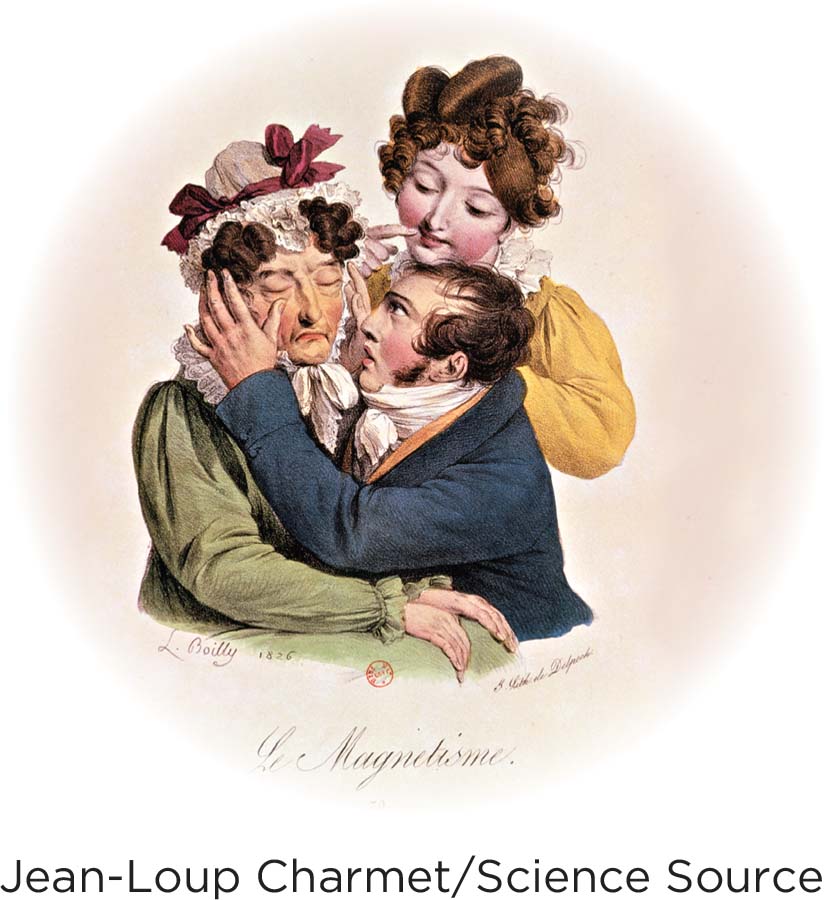
A 19th-
People can be hypnotized without consent: You cannot force someone to be hypnotized; they must be willing.
Hypnotized people will act against their own will: Stage hypnotists seem to make people walk like chickens or miscount their fingers, but these are things they would likely be willing to do when not hypnotized.
Hypnotized people can exhibit “superhuman” strength: Hypnotized or not, people have the same capabilities (Druckman & Bjork, 1994). Stage hypnotists often choose feats that their hypnotized performers could achieve under normal circumstances.
Hypnosis helps people retrieve lost memories: Studies find that hypnosis may actually promote the formation of false memories and one’s confidence in those memories (Kihlstrom, 1985).
Hypnotized people experience age regression. In other words, they act childlike: Hypnotized people may indeed act immaturely, but the underlying cognitive activity is that of an adult (Nash, 2001).
NO ONE CAN FORCE YOU TO BECOME HYPNOTIZED
Hypnosis induces long-
term amnesia: Hypnosis cannot make you forget your first day of kindergarten or your wedding. Short- term amnesia is possible if the hypnotist specifically suggests that something will be forgotten after the hypnosis wears off. 

A doctor in Belgium performs hypnosis on a patient undergoing a painful procedure. For those who are susceptible to hypnosis, this approach may diminish the need for anesthesia.
Now that some misconceptions about hypnosis have been cleared up, let’s focus on what we know. Researchers propose the following characteristics are evident in a hypnotized person: (1) ability to focus intently, ignoring all extraneous stimuli; (2) heightened imagination; (3) an unresisting and receptive attitude; (4) decreased pain awareness; and (5) high responsivity to suggestions (Kosslyn, Thompson, Costantini-
167
Does this process have any application to real life? With some limited success, hypnosis has been used therapeutically to treat phobias and commercially to help people change lifestyle habits (Green, 1999; Kraft, 2012). Hypnosis can also be used to reduce headaches and other pains associated with stress (Patterson & Jensen, 2003). Research also suggests that hypnosis does ease the pain associated with childbirth and surgery, reducing the need for painkillers (Cyna, McAuliffe, & Andrew, 2004; Wobst, 2007).
A SESSION WITH A HYPNOTIST Imagine you are using hypnosis for one of these purposes—
Once in this altered state of consciousness, you may be open to suggestion. If, say, the hypnotist suggested you could not lift your feet off the ground, then you might actually feel this way. Or if she suggested that you will not remember your own middle name after coming out of hypnosis, this posthypnotic suggestion may very well play out.
People in hypnotic states sometimes report having sensory experiences that deviate from reality; they may, for example, see or hear things that are not there. In a classic experiment, participants were hypnotized to believe they wouldn’t experience pain when asked to place one hand in a container filled with ice-
With the help of PET scans, some researchers have found evidence that hypnosis induces changes in the brain that might explain this diminished pain perception (Faymonville et al., 2000; Rainville, Duncan, Price, Carrier, & Bushnell, 1997). Dr. Julien agrees that hypnosis, meditation, and other relaxation techniques may indeed reduce anxiety and pain, but only to a certain extent. So if you plan to go under the knife with hypnosis as your sole form of pain management, don’t be surprised if you feel the piercing sensation of the scalpel.
THEORIES OF HYPNOSIS There are many theories to explain hypnosis. One hypothesis, referred to briefly above, is that hypnotized people experience a “split” in awareness or consciousness (Hilgard, 1977, 1994). According to this perspective, there is an ever-
Others have suggested that hypnosis is not a distinct state of consciousness, but more of a role-
168
FADE TO BLACK It is time to conclude our discussion of consciousness, but first let’s run through some of the big picture concepts you should take away from this chapter. Consciousness refers to a state of awareness—
show what you know
Question 1
1. Match the agent in the left column with the most appropriate outcome in the right column:
| ____ 1. depressant | a. blocks pain |
| ____ 2. opioid | b. slows down activity in the CNS |
| ____ 3. alcohol | c. increases neural activity in the CNS |
| ____ 4. cocaine | d. cirrhosis of the liver |
1. depressant: b. slows down activity in the CNS; 2. opioid: a. blocks pain; 3. alcohol: d. cirrhosis of the liver; 4. cocaine: c. increases neural activity in the CNS
Question 2
2. An acquaintance described an odorless, tasteless, and colorless substance he took many years ago. He discussed a variety of changes to his sensations and perceptions, including seeing colors and spirals. It is likely he had taken which of the following hallucinogens:
alcohol
nicotine
LSD
cocaine
c. LSD
Question 3
3. Dr. Julien uses a range of ________________ to dull the perception of pain, to inhibit memories of surgery, and to change a variety of psychological activities.
psychoactive drugs
Question 4
4. People often describe dangerous or risky behaviors as being addictive. You might hear a character in a movie say that he is addicted to driving fast, for example. Given what you have learned about physiological and psychological dependence, how would you determine if behaviors are problematic?
To determine if behaviors should be considered problematic, one could evaluate the presence of tolerance or withdrawal, both signs of physiological dependence. With tolerance, one’s system adapts to a drug over time and therefore needs more and more of the substance to re-